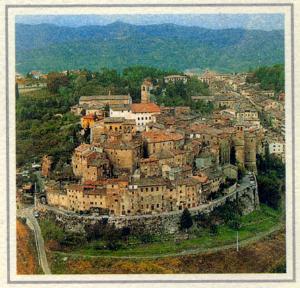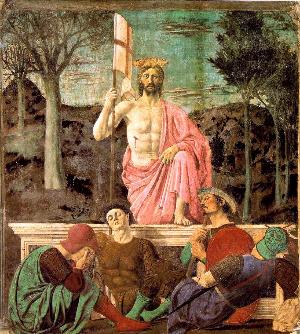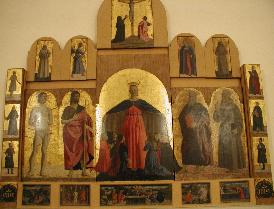|



| |
|

Anghiari from Busatti Brochure
|
|
What a surprise this little southern
Tuscany town turned out to be. We
set out for it to find the Busatti linen showroom, at least that
was one of Kris’s main goals for our stay in Umbria.
We had read about Busatti in a magazine and their goods looked
sufficiently unique to seek it out. I
was able to envelope Anghiari in an agenda to see the frescos of Peiro
del San Francesco in Sansepolcro and Arezzo – but the surprise was
in the middle.
We left Deruta in the drizzly rain and it just
intensified, letting us know it would be gray and wet all day.
The clouds were hugging the hills and only occasionally could we
see the majesty along the highway as we headed north to Sansepolcro,
our first stop. Our target
was the Museuo Civico to see their collection of Piero’s work,
but especially a single work of art, his famous Resurrection.
We got a relatively early start after lingering too long over
Anna’s far-too-good breakfast cakes.
We needed enough time to see the museum and make it over to
Anghiari to visit the Busatti shop, all before 1:00pm when we know
everything would close down for lunch.
Sansepolcro
Sansepolcro is on the western edge of the
Valtiberina, the bowl-like plane of the upper Tiber River.
Being flat, a modern city has grown around the ancient medieval-walled
core, providing an interesting juxtaposition for a working city.
Just before entering the ancient city gate, there is a small park with a
war memorial. You see these in
almost every Italian city, constant reminders that this little peninsular has
been a battleground for much of its history.
This is one of those that wrenches my emotions.
It is a partial bronze wall with very Fascist sculptures in deep relief
in a triptych design. In the
middle, tormented and fearful devils in army helmets are reining horror on the
world; on the left a man in a suite with his hands tied behind him is hanging
from an invisible rope. A partisan. Murdered by the Nazis.
The image of the partisan really moved me.
The heroism of civilians fighting for their liberty is truly moving.
Constantly in Italy we are confronted by people who tell us that the
United States is very important to them, because they will never forget that
many of our young men gave their lives in order to give them freedom. They
really believe the Americans liberated them from their own maniacal government
and the total tyranny of the occupying Germans.
I tried to get a picture, but the rain and fog made it too dark and the
figures flat and lifeless. Fascist
art is not appreciated enough. It
is very emotional and deserves more serious consideration. Maybe enough time has past for the stigmata to be lifted
and for people to look more seriously at it independent of the horrors its
philosophy delivered. Sure it
can be grandiose, even flamboyant or vulgar, but it can also be stirring and
clean and simple.
|
|
The Resurrection didn’t
disappoint, and was certainly worth the special trip.
The Museuo Civico is a delightful, small museum with an impressive
collection of Pieor’s works – appropriate as Sansepolcro was his home town.
The Resurrection occupies the end wall of a generous long gallery
uncluttered with much to distract from this fresco. A really marvelous gesture: the wall opposite the fresco has
a large grand exterior doorway. The
door is left open during business hours and the doorway is glassed-in, allowing
the general non-paying populace to climb the exterior staircase and view
the Resurrection. There are
several other marvelous Piero frescos in the room, including the beautiful
fragment of St. Julian, but the Resurrection is totally
captivating.
The thing that struck me about it was the obvious use of geometry
and the contrived painterly placement of the figures.
This is not verismo and could never be mistaken for a Caravaggio, for
instance. But as you look at the images of the figures, you are
captivated, almost mesmerized, by their haunting faces.
Starting with Christ, straight frontal, staring straight at you.
Then as your eyes move to the soldiers sleeping below – almost a
separate painting, the amazingly strong neck of one of the sleeping solders
grabs your attention. Actually, I was
particularly struck by a resemblance to the murals of Maxfield Parish,
especially King Cole at the St. Regis bar in New York. Art experts
will probably laugh as such a comparison, but I wonder if Parish admired
Piero. The Resurrection is a
wonderful painting. |

The Resurrection

St. Julian
Both images from The Web Gallery
A truly wonderful European Art resource
|
|

The Polyptych of the Misericordia
My illegal photo

Detail View
|
The other great Piero at
the museum is the Polyptych of the Misericordia, with its lovely image of
the Virgin enfolding the patrons in her robes, flanked by prominent saints,
including a wonderful image of St. Francis and an almost completely nude St.
Sebastian. A wonder of traveling at
this time of year, we had this museum and almost every other one we visited to
ourselves. Literally, rousing
attendants as we entered galleries to turn on the lights.
As we entered this room, however, a photographer was setting up a very
elaborate array of equipment to take official photographs of the polyptych.
I took out my little digital and motioned to him.
He shrugged, so I snapped a picture it, summoning a polite
official informing me that this was not to be done.
After, the photographer told me he would prefer to have my simple camera
with the digital preview, and he would gladly trade his large format 4 x 5 view
camera! I should have taken him up on it. I collaborated with him by noting that the polyptych was
extremely difficult to photograph because of all the gilded background, making
it almost impossible to light without getting monstrous reflections.
“Exactly! They don’t
understand this!” waving his arm at the invisible administrari. |
|
One of my guide books mentioned a bit of history that
enticed me even more to visit this small museum.
During the second World War, this town was occupied by the Germans near
the end of the war (the memorial mentioned earlier testifies to how folks felt
about that!). The command came down
to bomb the town. The RAF officer
in charge was an art buff and know of the existence of the Pieros – especially
the Resurrection - and delayed the order until the Germans had retreated
to the outskirts of the town. So.
There it is, for all of us to see. A
painting from 1465 that saved a lovely town from destruction.
|
 |